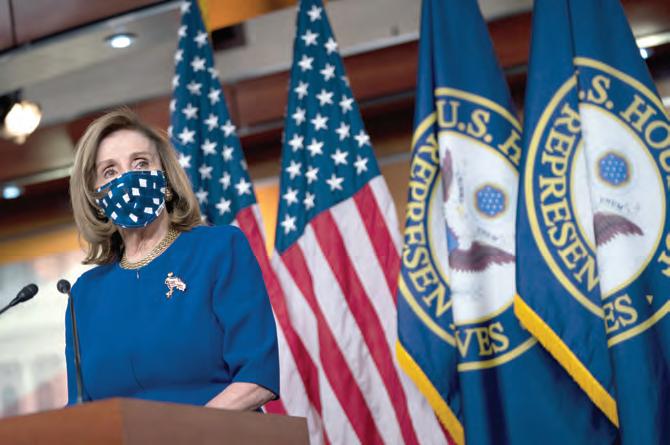Opinion
DAILY REPUBLIC — Wednesday, December 2, 2020 B3
This week’s question:
Should California’s undocumented immigrants be excluded from the census? Go to www.dailyrepublic.com/pulsepoll to vote.
commentary
Letters to the editor
Israel gets a vote on Iran nuclear deal
Letters must be 325 words or less and are subject to editing for length and clarity. All letters must include the author’s name, address and phone number. Send letters to Letters to the Editor, the Daily Republic, P.O. Box 47, Fairfield, CA 94533, email to gfaison@dailyrepublic.net or drop them off at our office, 1250 Texas St. in Fairfield.
W
hen asked when the wars in Iraq or Afghanistan might end, retired Gen. David Petraeus would deploy a useful quip. “The enemy gets a vote,” he would say, meaning that both sides need to agree to stop fighting. There is a corollary to Petraeus’ adage that is relevant not to war but to peace agreements: The allies get a vote, too. In the context of the 2015 nuclear agreement with Iran, the allies include Israel, which was not a party to the deal but is almost certainly responsible for last weekend’s assassination of Iran’s top nuclear weapons scientist, Mohsen Fakhrizadeh. Israel has repeatedly declined comment on the Fakrhizadeh operation, which comes after a string of Israeli sabotage actions over the summer against some of Iran’s most sensitive nuclear sites. Earlier this month, it was reported that Israeli teams killed al-Qaida’s deputy outside of Tehran. When Israeli Prime Eli Lake Minister Benjamin Netanyahu announced to the world that Israeli operatives had stolen reams of detailed Iranian schematics and plans for building a nuclear weapon in 2018, he urged the audience to remember Fakhrizadeh’s name, revealing a memo from the late scientist describing covert nuclear activities. Since the news broke of the assassination, the European Union as well as several former officials of the Barack Obama administration have issued condemnations. Former CIA director John Brennan, for example, mused that if a foreign country was responsible, it would be “an act of state-sponsored terrorism.” That’s myopic. To start, Iran’s pursuit of nuclear weapons poses an existential threat to Israel and Gulf Arab states such as the United Arab Emirates. It’s not that Iran would launch a first strike against one of these nations. Rather, it’s that all of Iran’s other destabilizing actions – supporting terrorists, arming regional insurgents, building up a long-range missile capability – would be much harder to deter if Iran possessed an atomic weapon. In this sense, it’s mistaken to view Israel’s likely strike against Fakhrizadeh through the lens of its effect on President-elect Joe Biden’s goal of re-entering the Iran nuclear deal and negotiating a stronger follow-on agreement. Israel has already proved it has extraordinary intelligence capabilities inside Iran. But the opportunity to take out a high-value target such as Fakhrizadeh does not come along often. It’s more likely that the opportunity presented itself and Israel pounced. More important, Israel has shown in the past three years that it is willing to use its intelligence capabilities to stymie Iran’s nuclear program. Israel killed some nuclear scientists inside Iran during negotiations over Iran’s nuclear program. Back then, most observers believed that Israel’s only chance to destroy Iran’s nuclear infrastructure was an overt action, such as a missile strike, drone attack or bombing run. The explosions at Iranian sites over the summer suggest Israel can accomplish much of this task through intelligence operations. The upshot is that any future deal with Iran will have to address Israel’s security needs. That is not what happened five years ago. The tensions of the nuclear deal became so dramatic that in 2015, Netanyahu addressed a joint session of Congress to make the case against the deal Obama was negotiating. Netanyahu was willing to risk Israel’s most important alliance to oppose a deal that he believed imperiled his country’s future. So it’s highly unlikely that Israel would be willing to end its activities in Iran so the U.S. can rejoin that same deeply flawed nuclear agreement. Israel may agree not to launch any strikes for a time, such as the first few months of the Biden administration. But it won’t give up the capability to strike inside Iran unless Iran agrees to abandon the aspects of its nuclear program suitable for building bombs. If Biden is smart, he will use this dynamic to his advantage as he tests Iran’s willingness to negotiate. Israel’s sabotage and assassinations have not destroyed Iran’s nuclear program. But they have set it back. As the architect of that program, Fakhrizadeh will be hard to replace. What will be even harder for the regime, however, is persuading its other scientists that they will be safe if they continue the quest for a nuclear weapon. Eli Lake is a Bloomberg Opinion columnist covering national security and foreign policy.
DAILY REPUBLIC A McNaughton Newspaper Locally Owned and Operated Serving Solano County since 1855 •
Foy McNaughton President / CEO / Publisher
T. Burt McNaughton Co-Publisher
Glen Faison Managing Editor
commentary
Get ready for supercharged economy
T
spending hinged on the he U.S. stock market had one of its best months assumption that there were ever in November, with no jobs available to compenthe S&P 500 Index sate for the income lost from surging almost 11%. Many are declining federal support. again questioning whether That was wrong, and will equities have become dislikely continue to be wrong connected to reality as the in aggregate. The underapCovid-19 pandemic rages preciated Job Openings and anew. Lost in the debate is Labor Turnover data Tim Duy the potential for an explosive indicate that job openings, economy in 2021 given the magniwhile down from the peak, did not tude of excess savings that housesuffer a decline like in the last holds have accumulated, a sum that recession and now hover at probably totals about $1.4 trillion. 2017 levels. Even the Federal Reserve is Rising wages and salaries means starting to realize just how beneficial that households can support spending this pot of money will be to the without touching accumulated economy going forward. At the savings. Of course, this doesn’t hold November Federal Open Market true for all households, but micro Committee meeting, Fed staff no stories are not the macroeconomy. In longer assumed that another round of aggregate, savings rates have fiscal stimulus is coming. The lack of remained persistently high even after such support was offset in their the economy moved through the first forecast by household savings. From fiscal cliff at the end of July. Although the minutes of the meeting: the saving rate, at 13.6% in October, “Although this lack of additional is down from the peak of 33.7% in fiscal support was expected to April, it’s still much higher than cause significant hardships for a pre-recession levels and the average number of households, the staff now of 7.5% in 2019. assessed that the savings cushion With Covid-19 vaccinations about accumulated by other households to commence, the economy will likely would be enough to allow total rebound quickly without the need for consumption to be largely maintained households to tap accumulated through year-end.” savings. (The median estimate of I have been focusing on excess economists surveyed by Bloomberg savings for some time now, but my is for the economy to expand 3.8% in prediction it would replace fiscal 2021 after contracting 3.6% this stimulus as the economy’s primary year.) The primary factory restrainmeasure of support was wrong. ing the economy is the services Savings did not cushion the economy sector, as spending on goods is above after the first fiscal cliff this past the pre-pandemic trend. A vaccine July; wages and salaries will allow the services sector to come were the cushion. online fairly quickly and close the Lost in the concern about fading output gap, or the distance between fiscal support has been the V-shaped where the economy is and where it recovery in wages and salaries, would have been in the absence of which are nearing their pre-panthe pandemic. demic levels and are even positive on Rough estimates of the output gap a year-over-year basis. indicate the economy should be The notion that fading fiscal producing 5% more goods and support would crash household services than were actually produced
in the third quarter. This is where we need to start thinking about the possibility that households tap their accumulated savings, pushing the savings rate below zero after the economy has largely normalized. Based on the same methodology I used in August, I estimate households have accumulated $1.4 trillion of excess savings, which is equivalent to about 6.6% of gross domestic product. This represents the remnants of the $2.2 trillion CARES Act passed by Congress in March. The hallmarks of that program included $1,200 payments for adults making up to $75,000 and $500 for their children, as well an extra $600 in weekly unemployment benefits. In addition, households save simply because their ability to consume services is constrained. Policymakers and market participants have yet to fully appreciate the magnitude of accumulated savings because the numbers are so large and out of historical context that they are difficult to comprehend. Also, there seems to be a false impression that savings are already being drawn down. That’s just not happening on an aggregate level. The thing to know is that these accumulated savings represent a massive amount of stimulus that is more than the current output gap and could spark an economy already set to normalize. I expect households will start spending their accumulated savings next year as confidence rebounds and very likely after the economy is already on its way to full recovery. It doesn’t take much imagination to see how that could supercharge an already vaccineinduced hot economy. Tim Duy is a professor of practice and senior director of the Oregon Economic Forum at the University of Oregon and the author of Tim Duy’s Fed Watch.
cALmatters Commentary
Court slaps down no-bid school contracts
A
construction money, quesn alternative view of California’s public school tioned the propriety of such system is that it is a huge contracts, declaring “the industry with 6 million integrity of the use of general customers who spend more obligation bonds . . . must be than $100 billion a year. above reproach” and sugThere’s big money to be gested that the made in supplying the goods lease-leaseback law and services those young be clarified. customers demand, which The warning went Dan Walters translates into political unheeded and no-bid leasejousting for pieces of the financial leaseback contracts proliferated. Los pie. Angeles Unified alone did more than A recent California appellate 70 projects worth more than court decision dealt with the syn$2.7 billion. Some have been scandrome – putting the brakes on one dals, involving favors to local school especially insidious practice that officials and bond campaign financallowed those with political pull to ing from contractors. profitably twist a law meant to help A notorious example occurred in local school systems build muchthe Fresno Unified School District in needed facilities. 2012 when Harris Construction Co. It dates back to 1957, when the received a lease-leaseback contract Legislature, seeking to help school for a middle school without bidding. districts cope with a tidal wave of The district paid for the construction baby boomer students, enacted in installments, and then assumed something called “lease-leaseback.” ownership on completion. It authorized a district to lease a Stephen Davis, a rival contractor, school site to a contractor for a token filed a double-barreled lawsuit amount. The contractor would build alleging that the contract violated the school and then lease it back to competitive bidding and conflict-ofthe district for up to 40 years, after interest laws, the latter because which ownership would revert to the district, bypassing the traditional use Harris had also been retained as a “consultant.” of voter-approved bonds. Fresno Unified’s superintendent, The law allowed a school contracMichael Hanson, received intense tor/lessor to be chosen without competitive bidding, and some school criticism in local media for his close relationship with Harris Construcofficials began misuing that exemption’s owner, Richard Spencer, tion with projects whose “leases” would last only through construction, including Spencer’s buying radio ads to praise Hanson’s performance and after which contractors would be underwriting his “state of education” paid off with state and local bond event. Eventually, as the lawsuit funds. wound through the courts, Hanson In 2004, the State Allocation Board, which parcels out school lost his job.
Both facets of the lawsuit prevailed, with one going to the state Supreme Court. Only one issue remained – whether Harris could be compelled to return the $37 million it was paid for the school, which the law calls “disgorgement.” With dozens of questionable lease-leaseback deals at risk, school construction firms attempted and failed to get legislation that would have protected them from disgorgement. Last month, an appellate court declared that “the remedy of disgorgement is available” in the Fresno Unified case, overturning a lower court ruling. Justice Donald Franson Jr. wrote in his opinion that the middle school contract functioned as a traditional construction contract and not a genuine lease, and should have been awarded by competitive bidding. Harris Construction may take the issue to the state Supreme Court, but having been rebuffed earlier, is unlikely to prevail. It’s a big win for Stephen Davis and Kevin Carlin, a San Diego lawyer who represented him and has pursued other questionable leaseleaseback cases. More than anything, however, the decision is a warning to construction companies and school officials that bending the law with sweetheart contracts is intolerable. CALmatters is a public interest journalism venture committed to explaining how California’s state Capitol works and why it matters. For more columns by Dan Walters, go to calmatters.org/commentary.








